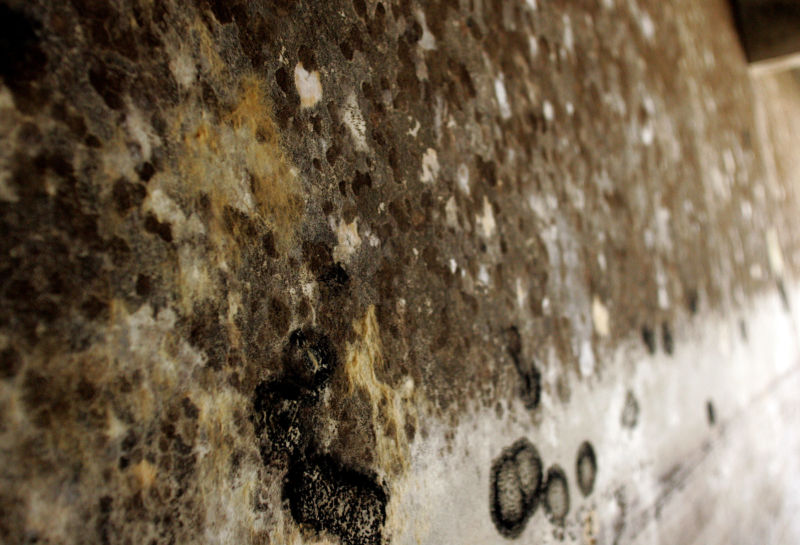We inhale up to 10 billion mold spores daily; here’s why you haven’t died yet
Hint: It’s not because our immune systems carry out mass fungi-cide.

Humans inhale somewhere between 1,000 and 10 billion mold spores on an average day—let alone on days after catastrophic flooding or a Category 5 hurricane hits, when fungal flare-ups can ensue. Each one of those teeny spores has the potential to embed in our moist, warm lungs. There they can unfurl fungal tendrils that grow like kudzu, invading and engulfing our organs, slowly choking the life out of us as mold bursts from our seams.
Luckily, our immune systems keep most of us safe from such an agonizing death. But they don’t pull it off with a bloody, fungal massacre each day—no, they use a much more dignified defense, according to a new study.
In the lung, immune cells get cozy with invading fungal spores, then trick them into pushing their own self-destruct buttons, researchers reported Thursday in Science. When the researchers used genetic engineering to override the spore’s self-destruct system, immune cells in mice were powerless to stop the fungal infiltration.
The findings suggest that our immune systems use a clever exploit to “maintain sterilizing immunity in the lung,” according to the researchers, led by infectious disease expert Tobias Hohl of Memorial Sloan Kettering Cancer Center.
But not all of us are so lucky. People whose immune systems are compromised from medications, other infections, or auto-immune disorders can’t always fight off the fungi. For those cases, the researchers are hopeful that the new insight into fungal defenses “may inform new strategies for therapeutic intervention in vulnerable patient groups.”
Musty munitions
To pick apart the fungal fray, researchers looked closely at how mammalian immune cells interacted with spores of Aspergillus fumigatus, the most common cause of mold pneumonia worldwide. They noticed that an important interaction seemed to take place between the spores and neutrophils, highly mobile immune cells that rush onto the scene of an invasion or injury to gobble up pathogens like Pac-Man and pump out chemical signals that boost inflammation responses.
In this case, neutrophils were engulfing—technically, phagocytosing—the A. fumigatus spores, but they weren’t killing them per se. Instead, the spores appeared to be dying of programmed cell death—aka cell suicide or apoptosis.
Programmed cell death (PCD) is a common mechanism in animals, plants, and fungi, in which a cell offs itself for the greater good. The self-destruct button gets hit in situations such as overwhelming stress conditions or when there’s irreparable damage to DNA. If a cell loses the ability to carry out PCD, it can be considered “immortalized.” Loss of PCD is a hallmark of cancer cells and tumor development.
To verify that the neutrophils were triggering PCD in the spores, the researchers turned to genetic engineering. They picked out a gene in the spore’s DNA that was like one in humans, known for encoding a protein called Survivin. In human cells, Survivin blocks PCD. So the researchers engineered the spores to overproduce their Survivin-like protein, making it much harder for them to self-destruct.
Fungi-cide
In mice, the spores loaded with Survivin didn’t die like normal, and they were deadlier to the mice—killing nearly three times the number of animals in one experiment. When the researchers looked closer, they found that the Survivin-enhanced spores caused “severe tissue destruction.” But when the researchers added a drug that blocks Survivin, the spores went back to dying in neutrophils and not causing as much lethal disease.
So how do the neutrophils get the spores to commit suicide? In lab, the researchers noticed that the spores packed with Survivin were better at surviving oxidative stress than normal. This gave the researchers the idea that the immune cells might be using an enzyme called NADPH oxidase to trick the spores into thinking they’re doomed in a stressful environment. That thinking falls in line with the fact that people who have a genetic defect in their NADPH oxidase gene have a much higher risk of getting an invasive fungal infection during their lifetime.
Sure enough, mice that lacked the enzyme were nearly defenseless against the spores, regardless of whether the spores had amped-up amounts of Survivin. In other words, without the stressful enzyme, the neutrophils couldn’t dupe the spores into committing suicide.
Together, the findings suggest our immune systems have a crafty technique for protecting us from fungi. If we can figure out an equally cunning exploit in the mold’s self-destruct system, the researchers hope we could some day better protect vulnerable patients.

Recent Comments